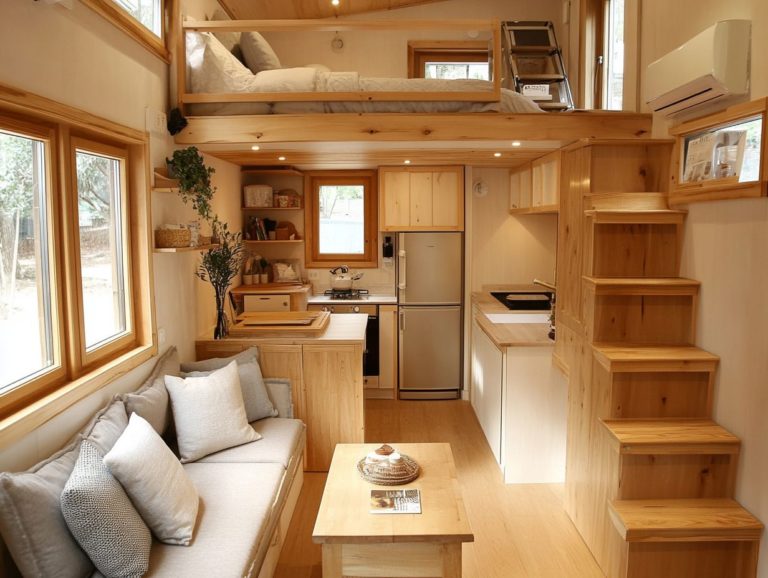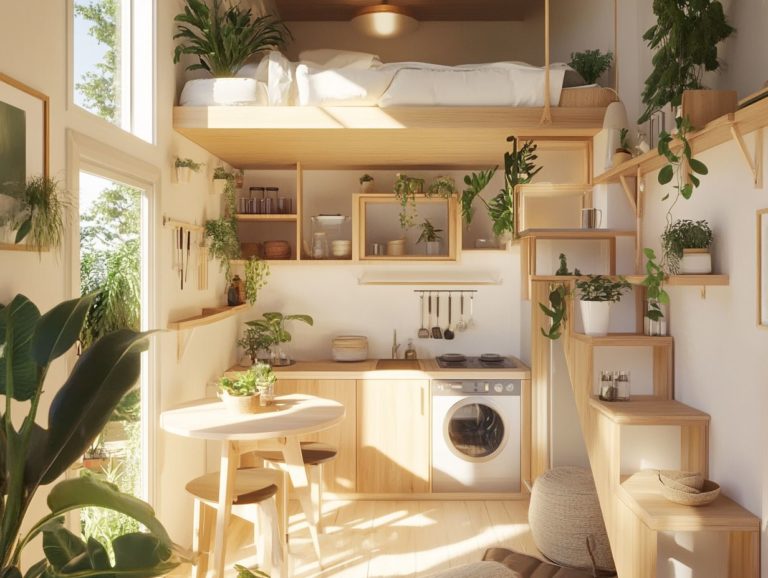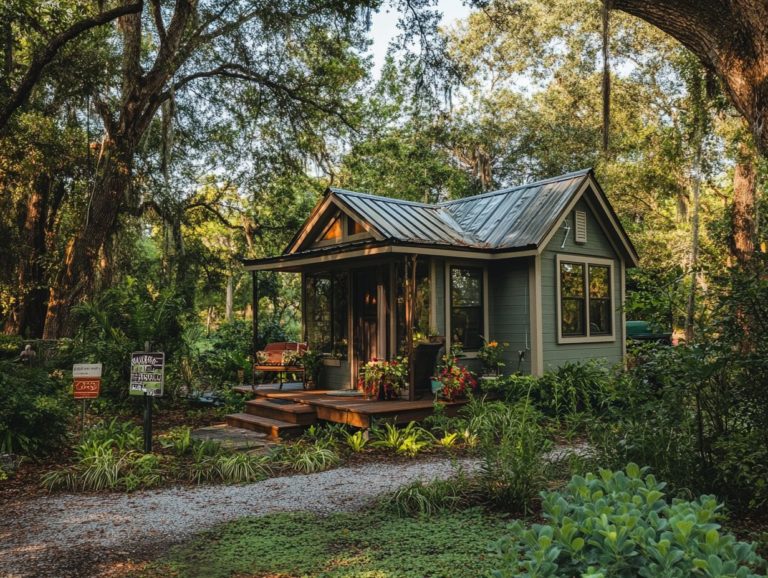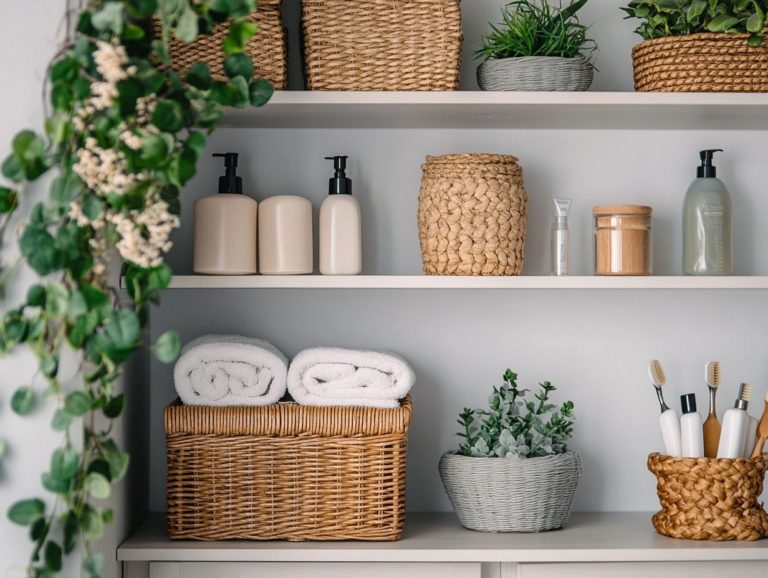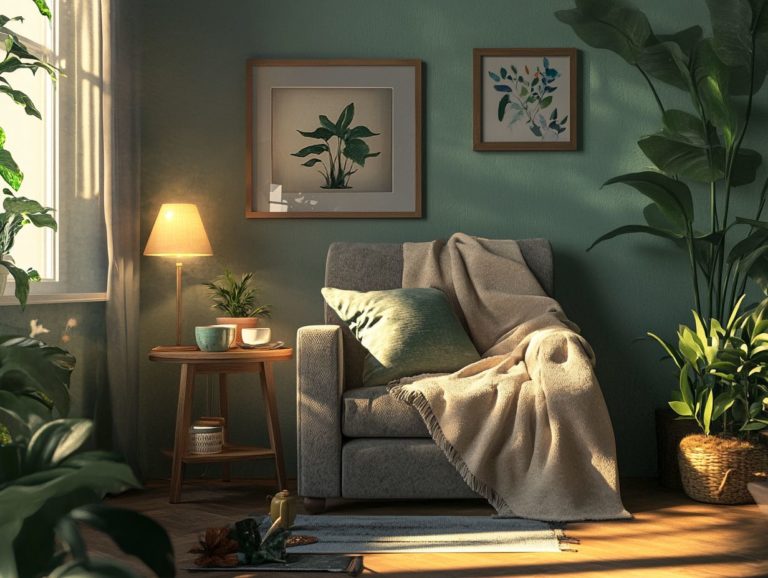Designing a Tiny House with Minimal Footprint
Tiny houses have undoubtedly captured your imagination, offering a refreshing perspective on living spaces that emphasize simplicity and sustainability.
Let s explore what makes tiny houses so special! This article discusses what defines a tiny house and the many benefits it brings, from reducing your environmental footprint to unlocking significant cost savings, including the rise of tiny homes as a vital response to the housing crisis.
You ll discover key design elements that make the most of small spaces while using sustainable materials. The challenges of zoning and living in tighter quarters will be examined, along with practical tips for building and fully embracing a minimalist lifestyle.
Embark on this journey as you navigate the fascinating world of tiny living!
Contents [hide]
- Key Takeaways:
- Benefits of Living in a Tiny House
- Cost Savings
- Designing a Tiny House with Minimal Footprint
- Maximizing Space and Functionality
- Sustainable Materials and Practices
- Challenges and Considerations
- Tips for Building and Living in a Tiny House
- Frequently Asked Questions
- What are the benefits of designing a tiny house with a minimal footprint?
- How can I ensure my tiny house has a minimal footprint?
- What are some strategies for maximizing space in a tiny house with a minimal footprint?
- Are there any specific design elements that are essential for a tiny house with a minimal footprint?
- Can I design a tiny house with a minimal footprint without sacrificing comfort?
- Are there any regulations or restrictions when it comes to designing a tiny house with a minimal footprint?
Key Takeaways:
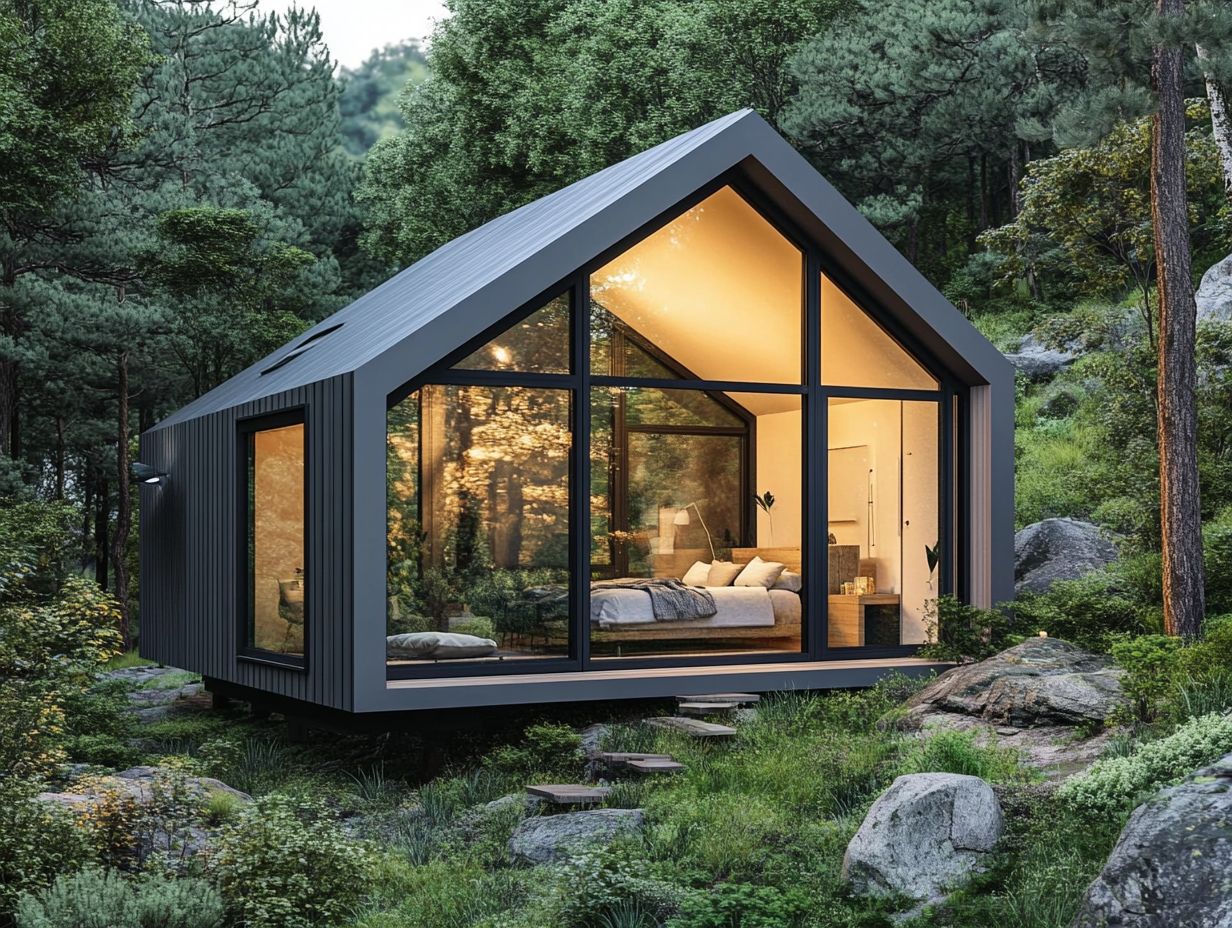
- Living in a tiny house positively impacts the environment by reducing energy consumption.
- Tiny houses save money on construction, maintenance, and utilities.
- Effective design and sustainable materials minimize environmental footprints.
What is a Tiny House?
A tiny house is your ticket to compact living, typically ranging from 100 to 400 square feet. It embodies the principles of micro living, a lifestyle that focuses on small, efficient homes, where minimalism and sustainability take center stage. These innovative designs often utilize eco-friendly materials, materials that are good for the environment, and multi-functional furniture to make the most of small spaces, aligning perfectly with modern architectural trends that tackle environmental concerns and the ongoing housing crisis.
Check out the amazing tiny homes designed by innovators like Yves Behar and El Sindicato Arquitectura; they re prime examples of the shift toward sustainable architecture and self-sufficient living, reflecting the principles of micro living.
This movement not only challenges your conventional notions of home but also encourages you to embrace a lifestyle focused on experiences rather than possessions. Often equipped with clever storage solutions and open-plan layouts, these cozy dwellings might feature lofted sleeping areas, fold-out tables, and even sliding walls that enhance adaptability.
Architectural gems like Casa Parasito and K Residence demonstrate how innovative design can create inviting yet functional spaces that feel just right. The cultural significance of the tiny house movement transcends mere aesthetics; it prompts you to rethink your relationship with material goods, fostering a rich sense of community and environmental stewardship.
Benefits of Living in a Tiny House
Embracing the tiny house lifestyle brings a wealth of advantages, from affordability to a significantly reduced carbon footprint. This minimalist approach not only simplifies your living space but also enhances your mental well-being by fostering a clutter-free environment.
As traditional housing costs continue to soar, tiny homes emerge as a compelling solution for those seeking budget-friendly options. You can enjoy the dual benefits of sustainable living and energy-efficient designs, all while creating a more intentional and fulfilling life.
Environmental Impact
The environmental impact of tiny homes is notably positive, as these compact living spaces often employ sustainable architecture to achieve a smaller carbon footprint. By choosing eco-friendly materials, innovative designs, and renewable energy sources, tiny houses effectively reduce their ecological impact while addressing pressing environmental concerns.
Innovative design techniques, such as maximizing natural light and optimizing space, minimize the need for artificial lighting and heating. Many tiny homes integrate solar panels, harnessing renewable energy to power essential appliances and decrease reliance on fossil fuels. Water conservation strategies, including rainwater harvesting and efficient plumbing systems, not only conserve this invaluable resource but also encourage responsible consumption.
The incorporation of energy-efficient appliances further bolsters their sustainability, allowing you to maintain a comfortable lifestyle while being mindful of your environmental footprint. Through these combined efforts, tiny homes represent a harmonious blend of modern living and ecological responsibility.
Cost Savings
Cost savings stand out as a significant advantage of living in a tiny house. These compact spaces typically demand less initial investment and come with lower utility bills. This makes them an appealing choice for anyone seeking affordable housing. With energy-efficient designs and a minimalist lifestyle, tiny homes enable you to spend less on essentials and channel more resources into experiences and sustainability.
This financial efficiency is crucial in tackling the housing crisis. It provides a practical solution for individuals and families grappling with high mortgage rates and soaring property values. By choosing a tiny home, you can substantially reduce your monthly expenses, including savings on utilities like water and electricity. Maintenance costs also tend to shrink due to the smaller size and straightforward design. This frees up your finances for other priorities, whether that’s travel or saving for the future.
In essence, tiny homes offer a modern and financially astute response to the pressing need for affordable housing options, merging design style with practical living.
Designing a Tiny House with Minimal Footprint
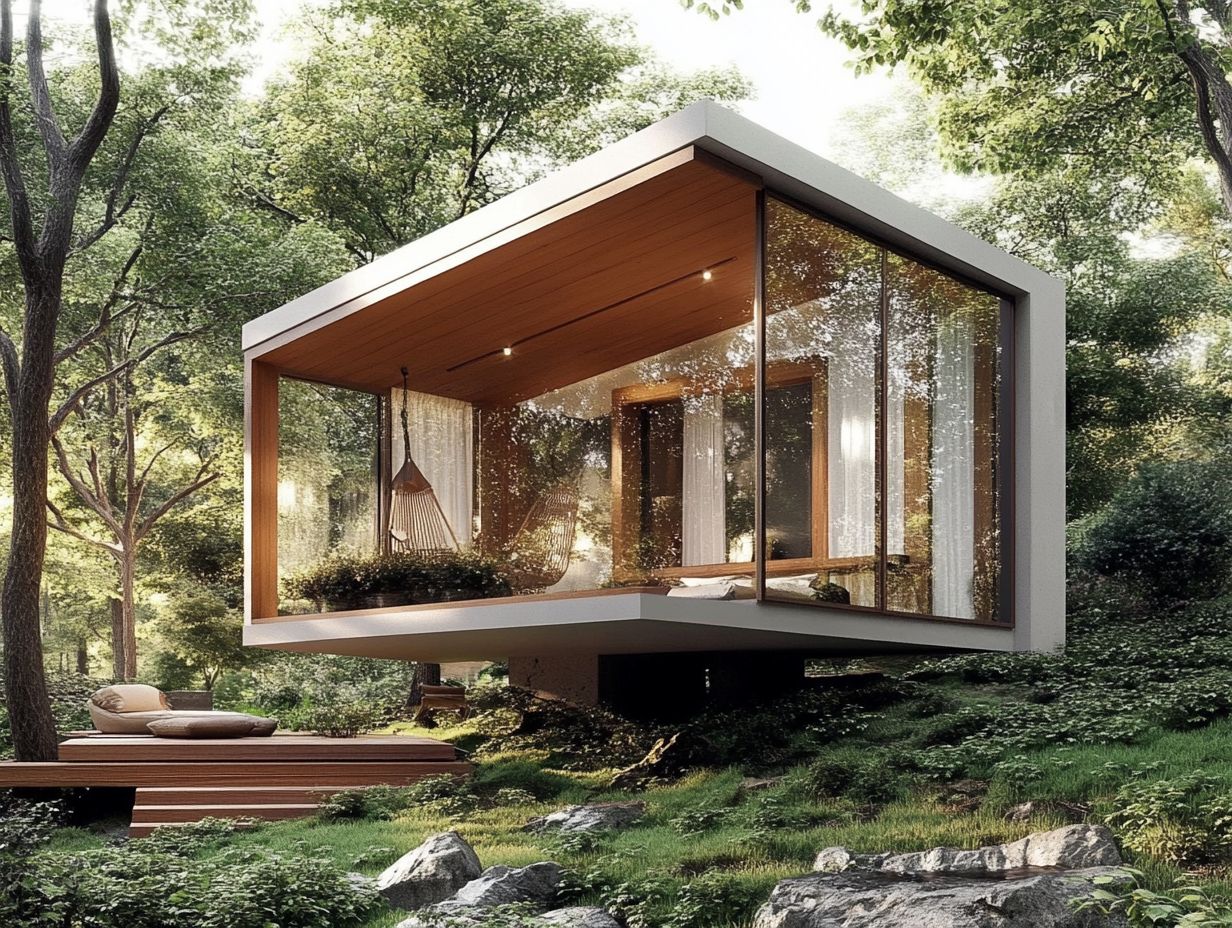
Designing a tiny house with a minimal footprint demands careful attention to space utilization, innovative design solutions, and the use of sustainable materials.
By embracing multi-functional furniture, high-grade insulation, and efficient heating systems, you can craft compact layouts that maximize functionality while also reducing your environmental impact.
This approach truly embodies the principles of the tiny house movement, allowing you to live simply yet elegantly.
Maximizing Space and Functionality
Maximizing space and functionality in tiny homes requires you to strategically embrace multi-functional furniture and innovative design techniques. These create a compact layout while preserving a sense of openness. Think of convertible sofas and built-in storage solutions these design innovations empower you to make the most of every square foot without ever feeling cramped.
Consider a dining table that folds into the wall or transforms into a desk. It not only saves precious room but also adds versatility to your small living area. Storage ottomans serve double duty as seating while cleverly concealing clutter. This makes them perfect for limited spaces.
By utilizing vertical space with shelving and hooks, you can keep your items organized and easily accessible. This further enhances the functionality of your cozy environment.
These smart strategies ensure that each piece in your home serves multiple purposes, allowing you to enjoy a comfortable, efficient lifestyle without sacrificing style or essential amenities.
Sustainable Materials and Practices
The use of sustainable materials and eco-friendly practices in constructing tiny homes is essential for reducing environmental impact and fostering a greener lifestyle. By prioritizing renewable resources, innovative construction techniques, and energy-efficient designs, you can create tiny houses that exemplify sustainable architecture and inspire a shift toward eco-conscious living.
Incorporating reclaimed wood, for instance, helps protect forests by reusing previously sourced materials. It also adds unique character to your home. Installing energy-efficient appliances lowers energy consumption significantly, making your daily life more sustainable.
Exploring innovative building materials like bamboo or recycled steel offers you durable options that minimize your carbon footprint. Using natural insulation materials further enhances energy efficiency while promoting a healthy indoor environment.
Together, these practices embody a holistic approach to construction. They showcase your potential to live harmoniously with nature while reducing your ecological impact. Start your tiny house journey today and contribute to a greener planet!
Challenges and Considerations
Living in a tiny house brings unique challenges and considerations, particularly regarding zoning and building regulations that vary by location.
These legal hurdles can significantly affect your ability to establish a tiny home in certain areas. You may need to navigate complex guidelines while adapting to life in a limited space, often influenced by growing urban areas.
Zoning and Building Regulations
Zoning and building regulations play a significant role in determining the feasibility of tiny homes. They often present challenges in growing urban areas.
These regulations dictate minimum lot sizes, structural requirements, and permissible occupancy. They can restrict your ability to find suitable locations for your compact living spaces.
Understanding these intricacies is essential for embracing the tiny living lifestyle. Many areas enforce strict codes that may require tiny homes to function as small homes added to existing properties, adding limitations to their use.
You can find potential solutions. Advocate for zoning changes or engage in community discussions aimed at relaxing these codes. Building relationships with local officials can open doors to alternative pathways for compliance.
Ultimately, having a thorough grasp of local regulations gives you the power to navigate hurdles effectively. This ensures you can achieve your minimalist housing dreams.
Living with Limited Space
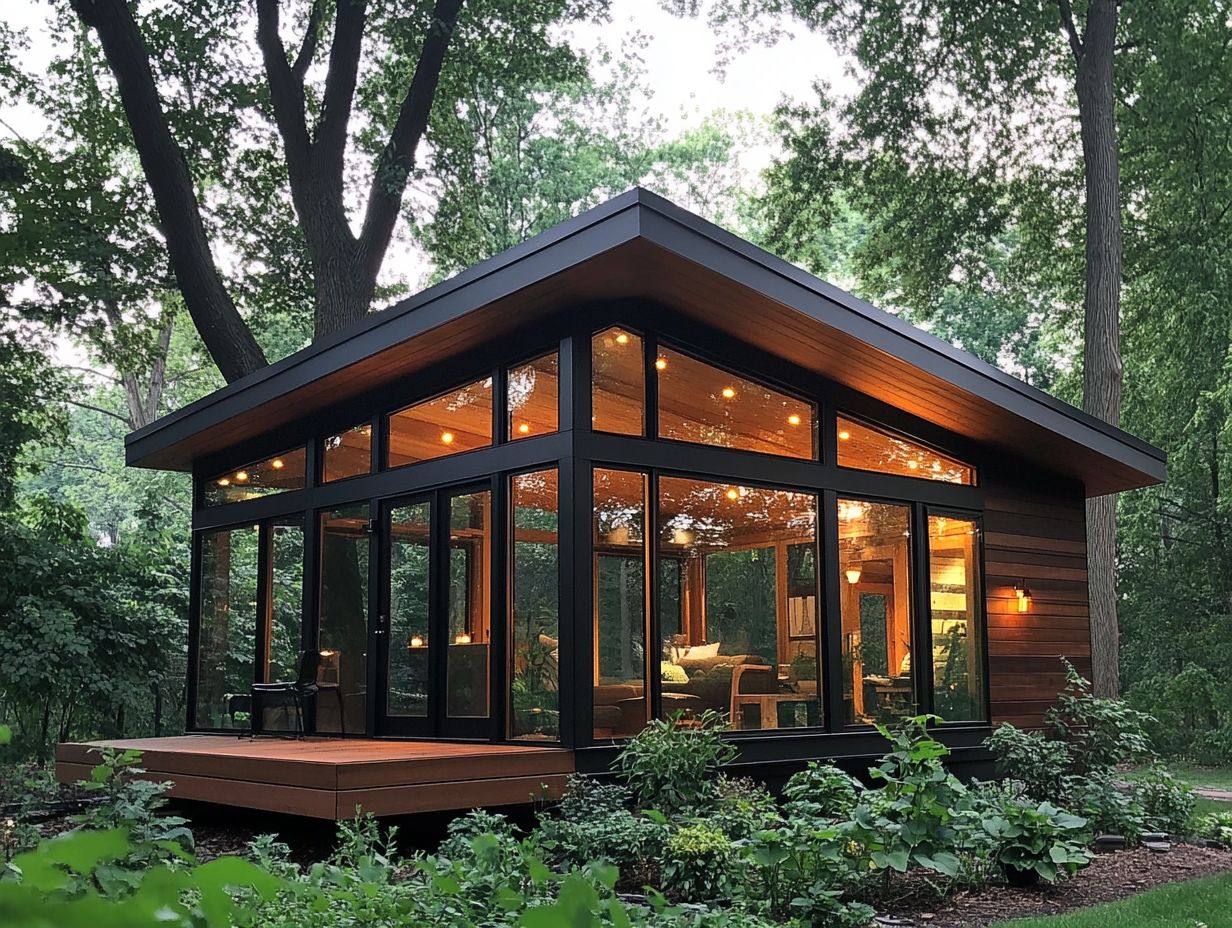
Living in a tiny home necessitates a shift towards a minimalist lifestyle. Here, intentionality and efficiency become paramount in your use of space.
Embracing the constraints of compact living opens up unique opportunities for creativity and innovation. It fosters a community-oriented mindset that values relationships over material possessions.
This adjustment enriches your daily experiences and prompts you to reassess what truly matters in life. By reducing clutter and focusing on essential belongings, discover the joy of simplicity and live a more fulfilling life!
The design of tiny spaces often encourages shared resources and communal areas, enhancing social interaction with your neighbors.
In this context, you ll learn to maximize every square inch effectively. Utilize multifunctional furniture and smart storage solutions that reflect your commitment to environmental sustainability.
Ultimately, adapting to this lifestyle nurtures a deeper connection not just to your home, but also to the vibrant community surrounding you.
Tips for Building and Living in a Tiny House
Building and residing in a tiny house demands careful planning. Dedicate yourself to adopting a minimalist lifestyle that elevates comfort and functionality.
By prioritizing energy-efficient design, optimizing space utilization, and focusing on essential features, you can cultivate a harmonious living environment tailored to your needs while promoting sustainability.
Essential Features and Tips for Comfort
Essential features for comfort in tiny homes encompass efficient heating systems, energy-saving appliances, and thoughtfully designed living spaces. These features prioritize natural light and usability.
By selecting the right elements, you can elevate your living experience while capitalizing on the benefits of a compact layout. Incorporating smart technologies like programmable thermostats and automated lighting can significantly enhance your energy efficiency.
Effective insulation plays a vital role; it maintains a stable indoor temperature, ensuring your comfort year-round. Opting for multi-functional furniture maximizes your space utility and provides flexibility for daily activities.
A well-planned tiny home can feel surprisingly spacious. This encourages a minimalist lifestyle, minimizing clutter and fostering a deeper appreciation for each carefully chosen element.
These thoughtful integrations contribute to a serene and inviting atmosphere, significantly enhancing your overall quality of life.
Maintaining a Simple Living Lifestyle
Maintaining a simple living lifestyle in a tiny home requires intentional choices about your belongings and how you utilize space. Additionally, ways to use less and recycle more can elevate your living experience.
By embracing innovative design and efficient organization strategies, you can create a serene, clutter-free environment that fosters mindfulness and contentment.
To achieve this, consider implementing effective decluttering techniques, such as the ‘one in, one out‘ rule. This encourages you to think carefully before bringing new items into your space. Mindful purchasing is essential; opt for multi-functional furniture that maximizes every square inch to minimize visual chaos.
Embracing sustainable living practices, like sourcing eco-friendly materials and using energy-efficient appliances, not only reduces your environmental impact but also enhances the aesthetic appeal of your tiny home. Additionally, maximizing natural light in tiny house designs can further elevate your space. Follow these principles to create a harmonious relationship with your surroundings, promoting overall well-being and satisfaction within your compact space.
Frequently Asked Questions
What are the benefits of designing a tiny house with a minimal footprint?
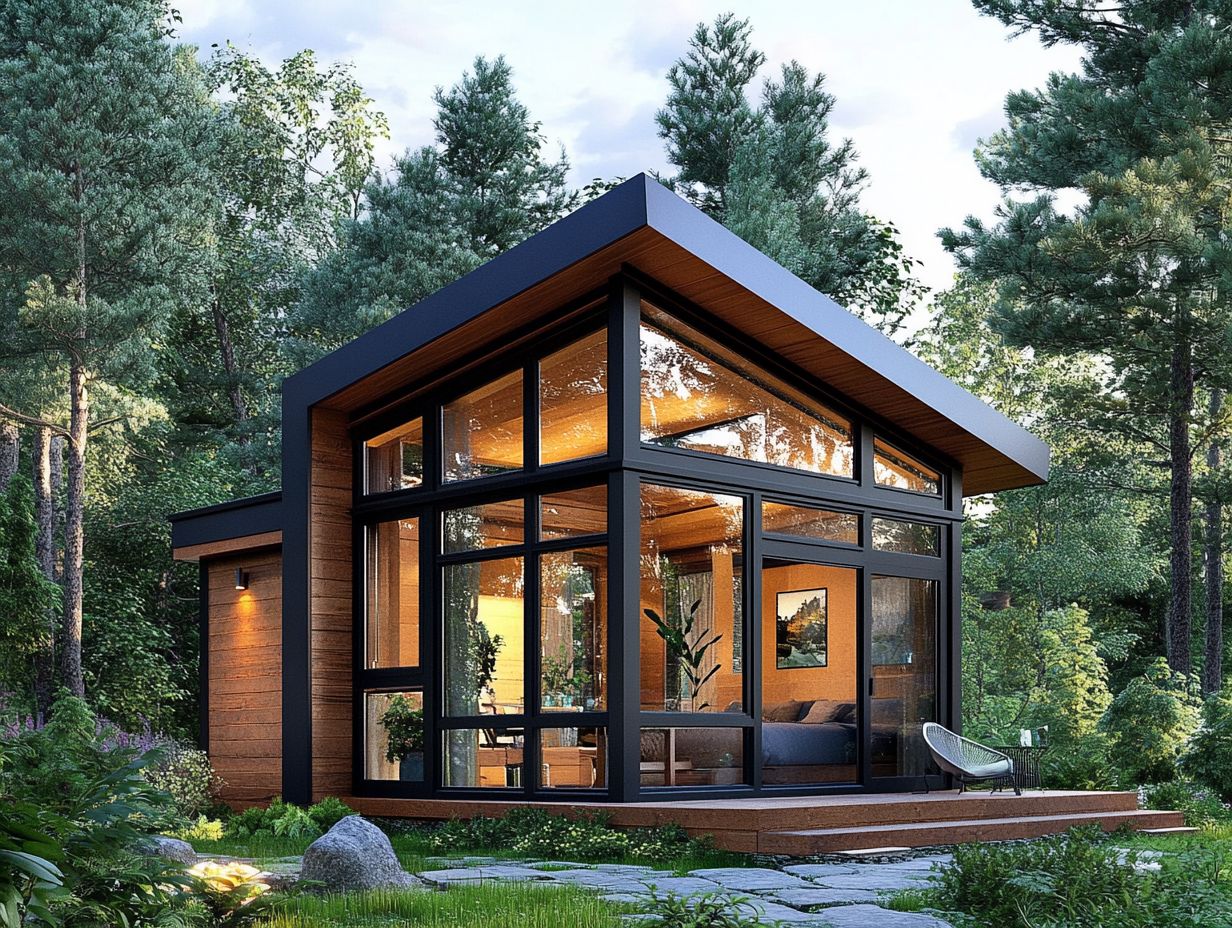
Designing a tiny house with a minimal footprint has several benefits. These include reduced environmental impact, lower maintenance and utility costs, and a simpler lifestyle.
How can I ensure my tiny house has a minimal footprint?
Use eco-friendly materials and plan your layout carefully for a minimal footprint. Incorporate energy-efficient features to enhance functionality.
What are some strategies for maximizing space in a tiny house with a minimal footprint?
Some strategies include utilizing multi-purpose furniture, incorporating storage solutions, and maximizing vertical space.
Are there any specific design elements that are essential for a tiny house with a minimal footprint?
Yes, essential design elements include a compact layout, energy-efficient features, and sustainable building materials.
Can I design a tiny house with a minimal footprint without sacrificing comfort?
Absolutely! With careful planning and creative design, you can have a comfortable and functional tiny house. Incorporating features like ample natural light, proper insulation, and adequate storage can make your tiny house feel spacious and cozy.
Are there any regulations or restrictions when it comes to designing a tiny house with a minimal footprint?
Regulations and restrictions for tiny houses vary by location. It’s crucial to research and comply with building codes, zoning laws, and size restrictions before designing your tiny house. Working with a professional designer or builder can help ensure compliance with all regulations.
Ready to start your minimalist journey? Explore more about tiny homes and embrace a simpler way of living!

